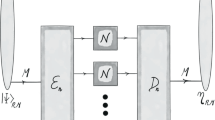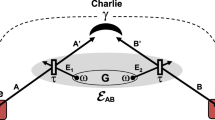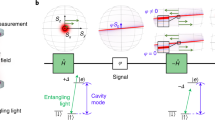Abstract
The two-way capacities of quantum channels determine the ultimate entanglement and secret-key distribution rates achievable by two distant parties that are connected by a noisy transmission line, in the absence of quantum repeaters. Since repeaters will likely be expensive to build and maintain, a central open problem of quantum communication is to understand what performances are achievable without them. Here we find a new lower bound on the energy-constrained and unconstrained two-way quantum and secret-key capacities of all phase-insensitive bosonic Gaussian channels, namely thermal attenuator, thermal amplifier and additive Gaussian noise, which are realistic models for the noise affecting optical fibres or free-space links. Ours is the first non-zero lower bound on the two-way quantum capacity in the parameter range where the (reverse) coherent information becomes negative, and it shows explicitly that entanglement distribution is always possible when the channel is not entanglement breaking. This completely solves a crucial open problem of the field, namely establishing the maximum excess noise, which is tolerable in continuous-variable quantum key distribution. In addition, our construction is fully explicit; that is, we devise and optimize a concrete entanglement distribution and distillation protocol that works by combining recurrence and hashing protocols.
This is a preview of subscription content, access via your institution
Access options
Access Nature and 54 other Nature Portfolio journals
Get Nature+, our best-value online-access subscription
$32.99 / 30 days
cancel any time
Subscribe to this journal
Receive 12 print issues and online access
$259.00 per year
only $21.58 per issue
Buy this article
- Purchase on SpringerLink
- Instant access to full article PDF
Prices may be subject to local taxes which are calculated during checkout

Similar content being viewed by others
Data availability
No data sets were generated during this study.
References
Bennett, C. H. & Bassard, G. Quantum cryptography: public key distribution and coin tossing. Theor. Comput. Sci. 560, 7–11 (2014).
Serafini, A. Quantum Continuous Variables: A Primer of Theoretical Methods (CRC Press, 2017).
Grosshans, F. & Grangier, P. Continuous variable quantum cryptography using coherent states. Phys. Rev. Lett. 88, 057902 (2002).
Pirandola, S. et al. Advances in quantum cryptography. Adv. Opt. Photonics 12, 1012–1236 (2020).
Laudenbach, F. et al. Continuous-variable quantum key distribution with Gaussian modulation—the theory of practical implementations. Adv. Quantum Technol. 1, 1800011 (2018).
Zhang, Y. et al. Long-distance continuous-variable quantum key distribution over 202.81 km of fiber. Phys. Rev. Lett. 125, 010502 (2020).
Hajomer, A. A. E. et al. Long-distance continuous-variable quantum key distribution over 100-km fiber with local local oscillator. Sci. Adv. 10, eadi9474 (2024).
Zhang, Y. et al. Continuous-variable QKD over 50 km commercial fiber. Quantum Sci. Technol. 4, 035006 (2019).
Pi, Y. et al. Sub-mbps key-rate continuous-variable quantum key distribution with local local oscillator over 100-km fiber. Opt. Lett. 48, 1766–1769 (2023).
Huang, D., Huang, P., Lin, D. & Zeng, G. Long-distance continuous-variable quantum key distribution by controlling excess noise. Sci. Rep. 6, 19201 (2016).
Wehner, S., Elkouss, D. & Hanson, R. Quantum internet: a vision for the road ahead. Science 362, eaam9288 (2018).
Pirandola, S. et al. Theory of channel simulation and bounds for private communication. Quantum Sci. Technol. 3, 035009 (2018).
Wilde, M. M. Quantum Information Theory 2nd edn (Cambridge Univ. Press, 2017).
Khatri, S. & Wilde, M. M. Principles of quantum communication theory: a modern approach. Preprint at https://arxiv.org/abs/2011.04672 (2020).
Davis, N., Shirokov, M. E. & Wilde, M. M. Energy-constrained two-way assisted private and quantum capacities of quantum channels. Phys. Rev. A 97, 062310 (2018).
Ekert, A. K. Quantum cryptography based on Bell’s theorem. Phys. Rev. Lett. 67, 661–663 (1991).
Pirandola, S., Laurenza, R., Ottaviani, C. & Banchi, L. Fundamental limits of repeaterless quantum communications. Nat. Commun. 8, 15043 (2017).
Briegel, H.-J., Dür, W., Cirac, J. I. & Zoller, P. Quantum repeaters: the role of imperfect local operations in quantum communication. Phys. Rev. Lett. 81, 5932–5935 (1998).
Munro, W. J., Azuma, K., Tamaki, K. & Nemoto, K. Inside quantum repeaters. IEEE J. Sel. Top. Quantum Electron. 21, 78–90 (2015).
Goodenough, K., Elkouss, D. & Wehner, S. Assessing the performance of quantum repeaters for all phase-insensitive Gaussian bosonic channels. New J. Phys. 18, 063005 (2016).
Takeoka, M., Guha, S. & Wilde, M. M. Fundamental rate-loss tradeoff for optical quantum key distribution. Nat. Commun. 5, 5235 (2014).
Holevo, A. S. & Werner, R. F. Evaluating capacities of bosonic Gaussian channels. Phys. Rev. A 63, 032312 (2001).
Wilde, M. M., Tomamichel, M. & Berta, M. Converse bounds for private communication over quantum channels. IEEE Trans. Inf. Theory 63, 1792–1817 (2017).
Takeoka, M., Guha, S. & Wilde, M. M. The squashed entanglement of a quantum channel. IEEE Trans. Inf. Theory 60, 4987–4998 (2014).
Pirandola, S., García-Patrón, R., Braunstein, S. L. & Lloyd, S. Direct and reverse secret-key capacities of a quantum channel. Phys. Rev. Lett. 102, 050503 (2009).
Noh, K., Pirandola, S. & Jiang, L. Enhanced energy-constrained quantum communication over bosonic Gaussian channels. Nat. Commun. 11, 457 (2020).
Ottaviani, C. et al. Secret key capacity of the thermal-loss channel: improving the lower bound. In Proc. Quantum Information Science and Technology II (eds Gruneisen, M. T. et al.) 999609 (SPIE, 2016).
Tamura, Y. et al. The first 0.14-db/km loss optical fiber and its impact on submarine transmission. J. Lightwave Technol. 36, 44–49 (2018).
Li, M.-J. & Hayashi, T. in Optical Fiber Telecommunications VII (ed. Willner, A. E.) 3–50 (Academic, 2020).
Peres, A. Separability criterion for density matrices. Phys. Rev. Lett. 77, 1413–1415 (1996).
Simon, R. Peres–Horodecki separability criterion for continuous variable systems. Phys. Rev. Lett. 84, 2726–2729 (2000).
Giedke, G., Kraus, B., Lewenstein, M. & Cirac, J. I. Entanglement criteria for all bipartite Gaussian states. Phys. Rev. Lett. 87, 167904 (2001).
Holevo, A. S. & Giovannetti, V. Quantum channels and their entropic characteristics. Rep. Prog. Phys. 75, 046001 (2012).
Holevo, A. S. Entanglement-breaking channels in infinite dimensions. Probl. Inf. Transm. 44, 171–184 (2008).
Pirandola, S. Limits and security of free-space quantum communications. Phys. Rev. Res. 3, 013279 (2021).
Wang, G., Ottaviani, C., Guo, H. & Pirandola, S. Improving the lower bound to the secret-key capacity of the thermal amplifier channel. Eur. Phys. J. D 73, 17 (2019).
Devetak, I. & Winter, A. Distillation of secret key and entanglement from quantum states. Proc. R. Soc. A 461, 207–235 (2005).
Dür, H. & Briegel, H. J. Entanglement purification and quantum error correction. Rep. Prog. Phys. 70, 1381–1424 (2007).
Bennett, C. H., DiVincenzo, D. P., Smolin, J. A. & Wootters, W. K. Mixed-state entanglement and quantum error correction. Phys. Rev. A 54, 3824–3851 (1996).
Bennett, C. H. et al. Purification of noisy entanglement and faithful teleportation via noisy channels. Phys. Rev. Lett. 76, 722–725 (1996).
Miguel-Ramiro, J. & Dür, W. Efficient entanglement purification protocols for d-level systems. Phys. Rev. A 98, 042309 (2018).
Vollbrecht, K. G. H. & Verstraete, F. Interpolation of recurrence and hashing entanglement distillation protocols. Phys. Rev. A 71, 062325 (2005).
Sanders, B. C. Quantum dynamics of the nonlinear rotator and the effects of continual spin measurement. Phys. Rev. A 40, 2417–2427 (1989).
Winnel, M. S., Guanzon, J. J., Hosseinidehaj, N. & Ralph, T. C. Achieving the ultimate end-to-end rates of lossy quantum communication networks. npj Quantum Inf. 8, 129 (2022).
Kalb, N. N. et al. Entanglement distillation between solid-state quantum network nodes. Science 356, 928–932 (2017).
Hu, X.-M. et al. Long-distance entanglement purification for quantum communication. Phys. Rev. Lett. 126, 010503 (2021).
Ecker, S. et al. Experimental single-copy entanglement distillation. Phys. Rev. Lett. 127, 040506 (2021).
Deutsch, D. et al. Quantum privacy amplification and the security of quantum cryptography over noisy channels. Phys. Rev. Lett. 77, 2818–2821 (1996).
Dehaene, J., Van den Nest, M., De Moor, B. & Verstraete, F. Local permutations of products of Bell states and entanglement distillation. Phys. Rev. A 67, 022310 (2003).
Horodecki, M. & Horodecki, P. Reduction criterion of separability and limits for a class of distillation protocols. Phys. Rev. A 59, 4206–4216 (1999).
Alber, G., Delgado, A., Gisin, N. & Jex, I. Efficient bipartite quantum state purification in arbitrary dimensional Hilbert spaces. J. Phys. A 34, 8821–8833 (2001).
Bombin, H. & Martin-Delgado, M. A. Entanglement distillation protocols and number theory. Phys. Rev. A 72, 032313 (2005).
Acknowledgements
F.A.M. and V.G. acknowledge financial support by MUR (Ministero dell’Istruzione, dell’Università e della Ricerca) through the following projects: PNRR MUR project PE0000023-NQSTI, PRIN 2017 Taming complexity via Quantum Strategies: a Hybrid Integrated Photonic approach (QUSHIP) Id. 2017SRN-BRK, and project PRO3 Quantum Pathfinder. L.L. was partially supported by the Alexander von Humboldt Foundation. F.A.M. and L.L. thank the Freie Universität Berlin for hospitality. F.A.M., L.L. and V.G. thank D. Miller, M. Rosati, M. Notarnicola, M. Avesani, M. Mazelanik and M. Barbieri for useful discussions.
Author information
Authors and Affiliations
Contributions
The entanglement distribution protocol was designed and optimized by F.A.M. The proof of Theorem 1 was found in a blackboard discussion between the three authors. F.A.M. wrote a first complete draft of the paper, which was subsequently improved by L.L. and V.G.
Corresponding authors
Ethics declarations
Competing interests
The authors declare no competing interests.
Peer review
Peer review information
Nature Photonics thanks Javier Fonollosa and the other, anonymous, reviewer(s) for their contribution to the peer review of this work.
Additional information
Publisher’s note Springer Nature remains neutral with regard to jurisdictional claims in published maps and institutional affiliations.
Supplementary information
Supplementary Information
36 pages of detailed derivations of our results.
Rights and permissions
Springer Nature or its licensor (e.g. a society or other partner) holds exclusive rights to this article under a publishing agreement with the author(s) or other rightsholder(s); author self-archiving of the accepted manuscript version of this article is solely governed by the terms of such publishing agreement and applicable law.
About this article
Cite this article
Mele, F.A., Lami, L. & Giovannetti, V. Maximum tolerable excess noise in continuous-variable quantum key distribution and improved lower bound on two-way capacities. Nat. Photon. 19, 329–334 (2025). https://doi.org/10.1038/s41566-024-01595-9
Received:
Accepted:
Published:
Issue date:
DOI: https://doi.org/10.1038/s41566-024-01595-9



